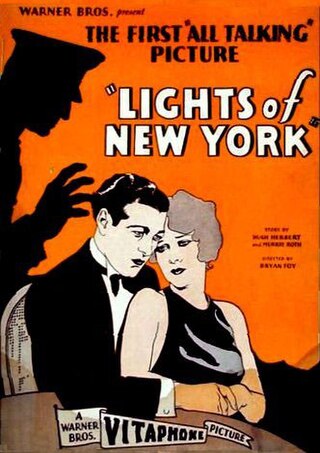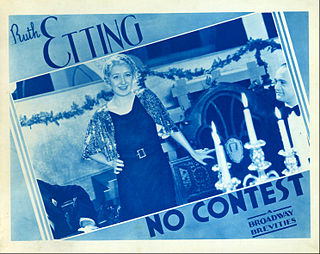Related Research Articles

Juanita Horton, better known as Bessie Love, was an American-British actress who achieved prominence playing innocent, young girls and wholesome leading ladies in silent and early sound films. Her acting career spanned nearly seven decades—from silent film to sound film, including theatre, radio, and television—and her performance in The Broadway Melody (1929) earned her a nomination for the Academy Award for Best Actress.

Vitaphone was a sound film system used for feature films and nearly 1,000 short subjects made by Warner Bros. and its sister studio First National from 1926 to 1931. Vitaphone is the last major analog sound-on-disc system and the only one that was widely used and commercially successful. The soundtrack is not printed on the film, but issued separately on phonograph records. The discs, recorded at 33+1⁄3 rpm and typically 16 inches (41 cm) in diameter, are played on a turntable physically coupled to the projector motor while the film is projected. Its frequency response is 4300 Hz. Many early talkies, such as The Jazz Singer (1927), used the Vitaphone system. The name "Vitaphone" derived from the Latin and Greek words, respectively, for "living" and "sound".

Edwin Fitzgerald, known professionally as Eddie Foy and Eddie Foy Sr., was an American actor, comedian, dancer and vaudevillian.

Don Juan is a 1926 synchronized sound American romantic adventure film directed by Alan Crosland. It is the first feature-length film to utilize the Vitaphone sound-on-disc sound system with a synchronized musical score and sound effects, though it has no spoken dialogue. The film is inspired by Lord Byron's 1821 epic poem of the same name. The screenplay was written by Bess Meredyth with intertitles by Maude Fulton and Walter Anthony.

Lights of New York is a 1928 American crime drama film starring Helene Costello, Cullen Landis, Wheeler Oakman and Eugene Pallette, and directed by Bryan Foy. Filmed in the Vitaphone sound-on-disc sound system, it is the first all-talking full-length feature film, released by Warner Bros., who had introduced the first feature-length film with synchronized sound Don Juan, in 1926; and the first with spoken dialogue, The Jazz Singer, in 1927. The film, which cost $23,000 to produce, grossed over $1 million. The enthusiasm with which audiences greeted the talkies was so great that by the end of 1929, Hollywood was producing sound films exclusively.

Queen of the Night Clubs is a 1929 American Pre-Code musical drama film produced and directed by Bryan Foy, distributed by Warner Bros., and starred legendary nightclub hostess Texas Guinan. The picture, which featured appearances by Eddie Foy Jr., Lila Lee, and George Raft, is now considered a lost film. A still existing vintage movie trailer of this film displays no clip of the feature.

Bryan Foy was an American film producer and director. He produced more than 200 films between 1924 and 1963. He also directed 41 films between 1923 and 1934. He headed the B picture unit at Warner Bros. where he was known as "the keeper of the B's".

The musical short can be traced back to the earliest days of sound films.
Russell Brown was an American actor of stage, television, and screen. He also had a career as a journalist, working for several newspapers in the city of Philadelphia. On stage, he is a best known for his Tony Award-winning role of Benny Van Buren in the 1955 Broadway musical Damn Yankees; a role he also reprised on film in 1958. Other highlights of his work in film were his portrayal of Captain Brackett in Rodgers and Hammerstein's 1958 movie version of the 1949 Broadway musical South Pacific, and as park caretaker George Lemon in the classic courtroom drama, Anatomy of a Murder (1959). On television he portrayed the recurring character of Thomas Jones, the father of the title character, in the legal drama The Law and Mr. Jones from 1960–1962.
Bubbles is a 1930 American Vitaphone Varieties short film released by Warner Bros. in Technicolor. It was filmed in December 1929 at the First National Pictures studio with Western Electric apparatus, an early sound-on-film system, Rel. No. 3898. Bubbles is one of the earliest surviving recordings of Judy Garland on film, at 8 years old.
The Sports Parade was a short film series of Warner Bros. that was regularly shown before the main studio feature, along with another Warner-Vitaphone short, Joe McDoakes comedy and/or Looney Tunes and Merrie Melodies cartoons. The average running time of each film was between nine and eleven minutes.

Vitaphone Varieties is a series title used for all of Warner Bros.', earliest short film "talkies" of the 1920s, initially made using the Vitaphone sound on disc process before a switch to the sound-on-film format early in the 1930s. These were the first major film studio-backed sound films, initially showcased with the 1926 synchronized scored features Don Juan and The Better 'Ole. Although independent producers like Lee de Forest's Phonofilm were successfully making sound film shorts as early as 1922, they were very limited in their distribution and their audio was generally not as loud and clear in theaters as Vitaphone's. The success of the early Vitaphone shorts, initially filmed only in New York, helped launch the sound revolution in Hollywood.
Technicolor Special was a common term used for Hollywood studio produced color short films of the 1930s and 1940s that did not belong to a specified series.

Broadway Brevities are two-reel musical and dramatic film shorts produced by Warner Bros. between 1931 and 1943. The series continued as Warner Specials in later years.
The Melody Masters were a series of first-rate big band musical film shorts produced by Warner Brothers, under the supervision of Samuel Sax at their Vitaphone studio in New York between 1931 and 1939, and in Burbank, California with producer Gordon Hollingshead in charge between 1940 and 1946.
Big Time Vaudeville was a series of black-and-white 9- to 10-minute short films resembling the Vitaphone Varieties and also produced by Warner Brothers and Vitaphone. These consisted of four to six vaudeville acts and are historically interesting with many performers rarely seen on film.
Warner Featurettes were an imprint for featurettes released by Warner Brothers.
Edwin B. DuPar was an American cinematographer, special effects technician, and film director who worked on hundreds of projects during his lengthy career in Hollywood, beginning in the early 1920s.
They Know Their Groceries is a 1929 Vitaphone Varieties short comedy film directed by Bryan Foy. It stars vaudeville comedy duo Flournoy Miller and Aubrey Lyles and features an African American cast. The plot involves inattentive grocers. Sam Sax was the producer.
References
- Citations
- 1 2 3 Love 1977 , p. 153
- 1 2 3 4 5 6 7 "Film Reviews: Talking Shorts". Variety. August 1, 1928. p. 12.
- 1 2 3 4 "Short Subject Reviews". The Film Daily. August 5, 1928. p. 7.
- 1 2 3 "Eddie Foy, Jr., with Bessie Love in The swell head / the Vitaphone Corp ; Hugh Herbert ; Murray Roth ; director, Brian Foy?". UCLA Library Film & Television Archive.
- ↑ Catalog of Copyright Entries, Cumulative Series: Motion Pictures 1912–1939. Copyright Office, The Library of Congress. 1951. p. 214.
- 1 2 3 Liebman, Roy (May 20, 2015). Vitaphone Films: A Catalogue of the Features and Shorts. McFarland. ISBN 978-1-4766-0936-2.
- ↑ Love 1977 , p. 111
- 1 2 Bradley, Edwin M. (June 14, 2015). "Warner Bros. / Vitaphone". The First Hollywood Sound Shorts, 1926–1931. McFarland. p. 435. ISBN 978-1-4766-0684-2.
- ↑ "Key City Reports". Motion Picture News. September 8, 1928. p. 798.
- Works cited